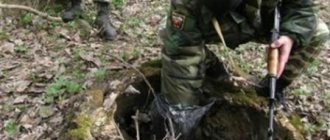Every tourist should know what caches in the forest are for. But not everyone understands how important it is to organize the cache correctly and reliably. It is not uncommon for wild animals to be found abandoned: bears, wolverines, mice. Tourists are left without food. It's good if everything ends well. Carelessness of travelers and improper organization of the cache can lead to tragic events. Before you go on a trip, you need to study what the cache is for, what rules are used to construct it, what equipment and products need to be put there. Let's figure out how to organize your cache so that your food and equipment remain unharmed.
What is a cache on a hike?
If you've ever gone camping, you probably know how heavy a backpack can be. Food, equipment, a change of clothes, personal supplies - you need to carry this on your shoulders. A backpack weighing 25-30 kg is common. So a cache on a hike is a real salvation; it significantly lightens the weight of the backpack.
A cache or stash, drop-off is a storage of food, equipment, fuel, organized along the route.
The main task when organizing a bookmark is to make it in such a way that it will not be discovered by anyone other than you.
When and why is a bookmark organized?
Drop-off during the hike is not organized on any route. For short trips, bookmarks are not made. They are provided in the following cases:
- On long routes, if entering populated areas is not planned;
- On circular routes, when the group returns to a point on the map where it was previously;
- When the weight of the backpack is initially high, for example due to mountain equipment. This also includes hikes with different categories of difficulty in different areas. If your journey begins in flat terrain and then turns to mountainous terrain, stowing your equipment will make life easier;
- During difficult sports trips, when the weight of things is critical;
- If possible, make a cache by arriving in advance by transport or pack animals.
What to hide in caches or caches?
Before we start actually creating caches, let’s think about what we should store. Obviously, these will not be capital warehouses with a 10-year supply. At the same time, they must satisfy at least minimal needs. The following categories can be distinguished:
- Food – Medicines (according to your level of knowledge in medicine);
- Means of exchange (alcohol, cigarettes, coffee, etc.);
- Life support items (according to survival priorities).
Essentially, this is a small alarm case outside the home. We will talk in more detail about the necessary supplies in the following publications.
What is left in the cache?
There are three main components of casting:
- Food.
- Equipment.
- Fuel.
On a long route, it is better to leave some of the food in the bag than to carry the weight on yourself. Keep in mind that food must be calculated for each section of the route, not forgetting about a small reserve. Anything can happen on the road: you get lost on the road or lose a day due to bad weather conditions. May you have food in reserve. In addition to the taken into account norm, do not forget to include a couple of tasty surprises: juices, canned fruits, and chocolates will delight travelers.
Hiking caches must contain camping equipment. It is better if the stash contains spare ropes, batteries for a flashlight, and medicines. Some travelers leave their clothes if the second part of the journey involves climbing mountains or another change in weather conditions. It is advisable to leave heavy equipment: crampons, ice axes.
Fuel is an important component of delivery. There is no need to carry all the gas burners that you will need on your trip at once. You can hide some of them.
SURVIVAL Supplies Outside the Home. ACCOUNTS.
Along with home storage, which you are able to frequently inspect and update supplies, it is also recommended to create remote strategic supplies - in camouflaged cellars or caches called caches and hiding places.
Partially, the garage and country cellar should be used (adjusted for possible looting).
But this is not enough. A necessary component of supplies are caches (aka caches, hiding places, hidden cellars).
There may be several circumstances for creating a cache: a) the need for additional storage space, b) a reasonable desire to disperse resources, c) creating criteria for instant escape from a populated area, without preparatory fees (the cache location will be the first point of your arrival after urgent self-evacuation).
The cache is a hiding place, located in a place remote from populated areas and roadways, and does not stand out from the outside. It can be arranged in an inconspicuous niche in the mountain, or you can simply bury supplies in the ground in the form of a treasure. The development of creating a cache is similar to the technology for equipping cellars, with the only difference being that the cache should not be noticeable from the outside.
When developing a cache, the main attention should be paid to disinfected cereals (heat-treated so that there is no mold, bugs, etc.), sugar and salt. You should also stock up on vinegar (for the rapid production of marinades that prolong the life of the product) and tea (in industrial foil packaging).
Not counting the goods, the cache must certainly contain: a minimum of pharmaceuticals, syringes and bandages, a bottle of honey alcohol, matches or a hammer, a roll of thick cellophane, a blanket (in a sealed package), rope or wire, an ax and a saw (lubricated with grease), liquid for lighting a fire, paper, a knife, a few disposable dishes, soap. Also, if you are driving: a can of gasoline, a set of keys.
Two methods of storing goods in a cache are recommended.
1st - an ordinary stowage, in which each product is stored in its own container (for example: a bag of sugar, 2 boxes of stew, 4 4 bottles of cereal, a canister of water, etc.) - of course, everything should be stored in waterproof packaging - i.e. e. at a minimum, it is wrapped in polyethylene and painstakingly closed.
2nd - extreme, when supplies are stored in whole sets, which contain a minimum of necessary goods (each set contains 3-5 kg of sugar, 10-15 kg of cereals of various types, 3-5 kg of milk powder, 1-2 liters of vegetable oil, 3-5 kg of dried fruits, 1 kg of salt, 200-300 g of spices, several cans of stew, a bottle of water, a bottle of vinegar, medicine, bandages, soap, an ax, something else).
This method allows you to quickly get supplies from the cache without attracting undue attention - after all, there may not be time for that.
To store the kits, it is recommended to use polyethylene containers with a wide mouth with a capacity of 40-60 liters. (1 tank = 1 set). The tank is easily and quickly removed, is not subject to erosion, and is resistant to pests.
If the cache is small, it is better to store only 2-3 sets and a roll of cellophane. If it’s large, you can add another container of sugar (40-60 liters), a couple of boxes of stew, a canister of water, a canister of alcohol, and a few tools (see above). You can also attach a simple battery-powered radio (it is possible that one of the radio stations will start broadcasting).
Take care to protect your supplies from mice, moles and rats. The tanks should be wrapped in a small iron net. The joints of the mesh pieces should be securely fastened with wire.
The cache must be securely hidden from human eyes, camouflaged. It is better if it is a thicket of forest, an island in a labyrinth of swamps, a crevice or a mini-grotto in a mountain.
You can arrange caches in the roots of trees, under old stumps, under large stones. The distance from the cache to the nearest populated area should be at least 3-4 km near a town and 5-6 km in rural areas (villagers know the area better - and can simply find the cache or see you while storing and retrieving supplies).
You should not equip a cache near military bases or large industrial companies, railway and boat stations (even if they are located far from the town).
You must be prepared for the fact that at the moment of removing supplies from the cache, someone else will want to appropriate some of your valuables for themselves. Or some people may threaten you with a weapon and demand that you give them your cache.
For this purpose, protective equipment must be provided in the cache. It is better if the approach to the cache is such that only one or two people can pass through (a narrow passage in the mountain or a rocky platform taller than a person, where only one person can climb, is especially comfortable).
If the cache is located in a forest, then there should be impenetrable thickets around it (raspberry, hazel, other shrubs, windbreaks), into which a person will not climb of his own free will.
And the approach to the cache is only one and very narrow. It is better to have a loaded weapon in the cache itself (a pistol, a sawn-off shotgun loaded with shot, a hand-held lemon). In case your hands are tied, you can secure a knife blade or a circular saw blade (wrapped in cellophane) in the immediate vicinity of the cache. At a critical moment, you can quietly cut the rope.
In these cases, children should not know about the existence of the cache. Or there should be several caches - only you understand about one, you + the kids understand about the other, only your spouse and kids understand about the third.
In order to minimize the possibility of detection of your cache, the stash should be made at night. To do this, you can camp not far from the intended location of the cache - under the guise of vacationers (it’s good if there is a river or other body of water nearby). And at night or at dawn it is inconspicuous to equip the cache. In this case, it is better not to light lanterns; it is advisable to go on a moonlit night. and the point is not so much that someone will see and someday later plunder the cache. They can see it right away and plunder it purely out of sporting enthusiasm.
Also, destroyed man-made structures such as mines, workings, old military structures, old military installations, remote industrial sites and buildings, abandoned villages, towns, etc. can be suitable as a dream for creating a cache. Obviously, you shouldn’t leave something in a visible place, but a big plus of such a cache will also be that in such a place you can not only store supplies, but also live for some time, practically without any additional equipment. preparation.
From time to time it makes sense to make a city cache (especially if you live in a large city and it is not always possible to leave it very quickly.)
When developing such a shelter, you should first make it inconspicuous, and the creation of the hiding place itself should be very inconspicuous.
You can try to organize caches under (your) garage on the street, Setting up a sheltered volume in the basement of a house or in the attic. use an abandoned bomb shelter, a section of underground communication (heating mains, unused collectors, etc.). You can arrange a cache using the basement deepening method, constructing a second bottom. The main thing is not to violate the integrity of the foundation.
Be especially careful that there are no signs of homeless people nearby.
A separate point might be to create a hiding place in the house where you live, but still this is not very important, because... The hiding place is needed just outside the house.
But if such a need arises, then it is most advisable to make a double bottom in the furniture, hiding places in the ventilation (from the inside there is a shelf or mount on which you can hang a bag, etc.). #survival_stash
Elen Adikaeva
Rules for organizing a cache
You have already seen that organizing hiding places and caches is an important component of any hike.
There are several rules for their organization:
- Containers and packaging of food and fuel The best containers for food and liquid fuel are plastic bottles and cans. Whatever you can, pour it in and pour it there. Obviously, the container must be clean and free from the smell of food, so as not to attract the main hunters - wild animals. Pack the bottles in plastic bags or cling film. Everything else can be put in thick plastic bags and containers. Be diligent. Poorly packaged food will be eaten by animals, leaving you at risk of running out of food in the middle of your trip.
- Place of hiding place Carefully choose the place where you will hide food and things. Choose a place that is mostly in the shade. Check to see if it is flooded. Equipment should not be left in low-lying areas or in the floodplain due to the risk of flooding. If the cache is organized in the forest, find a landmark: a large stone or a noticeable tree. Things are often placed in tree roots and covered with stones. When traveling through mountainous areas, a kurumnik can serve as an ideal place to lay it. Save the drop-off coordinates in a GPS navigator. If you do not have a GPS navigator, then the article: “Tourist GPS navigator for a hike in the forest” will help you decide on its choice.
- Food separately from equipment Be sure to hide food separately from equipment and fuel. The fact is that if the animals get to the food storage, they will not spare the equipment either. Rodents can easily chew through hidden ropes and ruin clothes.
- Note Another prerequisite for organizing a hiding place is leaving a note. It indicates: for whom the cache is organized, the date when the group will pick up the products, and also a request not to touch the things. The note is written in case someone else finds the drop first. Perhaps, after reading the message, the finder realizes that the lives of other people depend on the supplies left behind. The finder should not perceive the found treasure as a gift of fate; it is better to leave it in place.
How to prepare crackers so that you can store them for a long time, read here: “Preparing crackers for a hike: tips and recipes.”
Cache - hiding place - hiding place. Food supply hidden for years. How to make a cache in the forest along the route.
VKTwitterOK
video content
Rating: 4.0; Votes: 1 Human survival requires a supply of food. A cache of food, a hiding place in the forest, a hole in the ground Video channel: Maxim Medvedev - Category: Do It Yourself Date: 2020-10-18
← Survival in the forest (preparation, finding a place to survive, going into the forest, maps) part 1
Backpack (survival kit) survival in the forest for years with one backpack →
Related videos
Tricks of welding in blind spots. Don't bend the electrode, weld it backwards!
• Gori Duga
STRAWBERRY WILL ESTABLISH WELL AND PRODUCE BERRIES FASTER if you plant it this way!
• Tsvetok
BE SURE THAT YOU ARE HARVESTING TOMATOES CORRECTLY! Stages of ripeness and the best methods of ripening
• Tsvetok
THE LEAVES ON THE CUCUMBERS ARE TURNING YELLOW! Do this NOW and extend fruiting until autumn!
• Tsvetok
The shirt on the garlic has burst - it’s time to harvest. How to determine when it's time to dig up garlic
• Garden world
Be sure to plant this green manure after onions and garlic! You will really be satisfied!
• Smart farming
Comments and reviews: 10
Leontij We live on a round earth. someone on the flat. but it doesn’t matter since there is a circle around us. spin around and choose an escape route. in this case, the route can be a hundred meters in total. or maybe 10 kilometers. divide the circle into sectors. move away a hundred meters then a kilometer. You can go further if you don’t understand. means not given. then ask yourself. what is the probability? supplies to the cache. but about things for being in the forest for years. I'll keep quiet. I don’t want the narvat’s rudeness.
Alexander You don’t understand, while he walks through the forest, digs, thinks, reflects, looks, he, firstly, breathes fresh air, and secondly, bends down, digs, digs - this is physical therapy! And my head thinks all the time! That is, what he does is very good for health and soul! But there may not be a BP. more likely!
Dmitry Gorgeous ///But but nude//they hunt beavers or raccoons there or scare them so that they don’t go into the city zone ////there’s just a stream nearby, which means there could be beavers, raccoons also dig holes, and foxes are also good diggers /// For me personally it's too noticeable. that some animal was rummaging.
Vitaly People, why go somewhere? In case of war, we need to fight. and all these things for survival for the family need to be prepared and, of course, a hut or dugout for them. They can't survive without a home! where to run? who to fear? We Russians are not mice.
Ivan You need to take a GPS tracker and remember the coordinates and then write them down on a piece of paper, and the paper in a sealed pencil case. Then you can find it at any time. And you’ll find all these horseradish trees in 2 years, you’ll forget everything, or someone will cut down these trees and that’s it
Wess Instead of pasta, it is better to take normal cereals, dried apricots and stews. Why is this necessary at all? There's a cache in the forest, are you a forester or what? It is necessary to make a reserve at a point of permanent deployment, such as a hut. This is a cache for runaway prisoners. There is no other meaning.
asbastos I don’t know, pierce 10 cm of frozen ground with a knife. Moreover, it won’t be so easy on the square. To be fair, you should also add a package of multivitamins and freeze-dried meat or dried fish.
Juan I store food in a river in the forest, the temperature is stable and excellent, it doesn’t freeze in winter, and modern plastic containers last forever and can stay in water for decades
Alexander In your opinion, Tryndets is very close, because all sneaky products have a shelf life of a maximum of 2 years or less! Even in a sealed barrel in the ground!
Lucius Instead of pasta, it is better to put several packs of lentils, yellow or green, they are easier to digest and much healthier than empty pasta.










